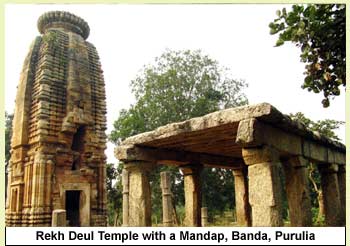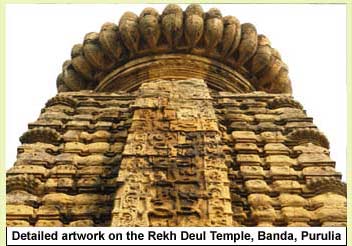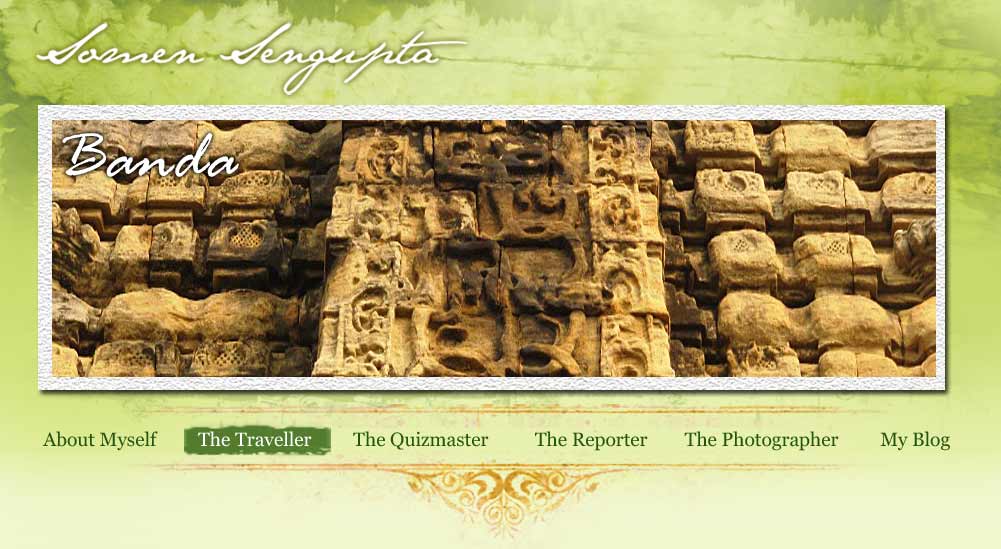| NEXT WEEKEND YOU CAN BE AT ... BANDA |
|
 A solitary abandoned temple steeped in history towers over the hamlet called Banda near Raghunathpur in Purulia. An incomplete masterpiece, the temple of Banda is worth a visit, especially for those interested in the history of Bengal. A solitary abandoned temple steeped in history towers over the hamlet called Banda near Raghunathpur in Purulia. An incomplete masterpiece, the temple of Banda is worth a visit, especially for those interested in the history of Bengal.
As no inscription stone or plaque has been found in the vicinity, it is almost impossible to figure out who the founder of the temple was. However, the ravages that it suffered at the hands of Muslim invaders find a mention in the annals of history.In 1872, archaeologist J.D. Belgar, busy working on the temples of the Manbhum region, came across this dilapidated temple, covered with deep vegetation inside a forest.
Thanks to Belgar's initiative, the Archaeological Survey of India undertook work on the temple. Scholars from various universities made this temple a subject of their study.One such scholar was Adrish Burman, who established that this structure had been vandalised by soldiers of Firoz Shah Tuglakh in 1360.From his work, scholars concluded that the incompleteness of construction was not because of any fault of the temple builders.
J D Beglar (1845-1907) one of the pioneer scholars of Indian archaeology started to explore the place and what he found was quite amazing. In (1872-73) when he started exploring the place, there were only five temples remaining out of 21. Now over the years, only three remain and all are in a dilapidated condition. The material used is a greenish chlorite stone, which is found in abundance in the area.
It is not clear whether it was a Hindu or a Jain temple. The jagmohan part of the temple (the middle tier of a typical Odisha-style three-tier temple) was never completed and the peerless floral design carved on soft stone on the front façade were badly defaced. The circled crown on the top (known as amalaka) was also broken.
In a book named Sirat-e-Firozshahi found in the Khudabaks library of Patna, it is mentioned that during the rule of Bhanudeb III, Firoz Shah attacked Odisha and by the middle of 1360, he entered Bihar and reached Panchet in Bengal via Jharkhand. His soldiers looted cities like Shikharbhum and Kiniyanagar. His army passed through the Keonjhar district and reached Cuttack.
 The rekh deul style of the temple indicates the influence of the Odisha school of design. The temple stands on a platform called jagati. The main door is in the north and there is no deity inside.Both the front and back of the main structure are richly decorated with floral designs. Some of them reflect the influence of middle-eastern Islamic art. The floor plan of the temple follows the tri-ratha style with a 13sq ft base. The rekh deul style of the temple indicates the influence of the Odisha school of design. The temple stands on a platform called jagati. The main door is in the north and there is no deity inside.Both the front and back of the main structure are richly decorated with floral designs. Some of them reflect the influence of middle-eastern Islamic art. The floor plan of the temple follows the tri-ratha style with a 13sq ft base.
The southern side is decorated with carvings depicting a large inter-weaving leafy stem. The doorframe is badly damaged but still contains some designs of boys blowing horns while climbing up a wavy stem, and a band of foliated scrolls. On the eastern side, water outlets built in the shape of makara heads are found.
There is a mandap in front of the temple. You can find eight pillars supporting a mesh of stone-made crossbeams. This structure lends a special charm to the temple.From Banda, you can visit Cheliama, a nearby village that houses a 300-year-old terracotta temple. Popularly known as the Radhabinod temple, it was established in 1697.Built in the aatchala style of the Bengal school of temple architecture, this temple has lost almost all its terracotta panels, except at the front.
The temple contains terracotta panels depicting the battle of Ram and Ravana with big chariots and foot soldiers and scenes from Krishnaleela. It is one of the very few surviving temples from 17th century Bengal.In the same village, there is a place called Mahamaya where you can find some excellent stone statues of Jain deities. It is interesting to note that these statues are now worshipped by Hindus in the village. Experts are of the opinion that these date back to the 12th century.
Some other nearby places of interest, especially if you are into archaeology, are Baghmundi, Birinchinath, Budhpur, Charra, Ganpur and Telkupi.
All these places boast ancient temples and architecture from different periods in Bengal's history.
Going
Banda is 51km from Purulia town. Take the Purulia Express from Howrah and get down at Adra station. From Adra (also known as Raghunathpur), you can either hire a car to Banda or travel by bus. Cheliama is just 3km from Banda. Ask local residents for guidance.
Staying
There is no place to put up at Banda or Cheliama. You have to return to Adra or Purulia to spend the night. Start early from Purulia or Adra so that you can spend most of the day exploring the temple village. Purulia and Adra have modest hotels and decent eateries. Carry lunch and snacks and water as there are no proper shops or eateries in Banda.
This article was published on 8th July, 2012 in The Telegraph
Click here to view the original article
|



